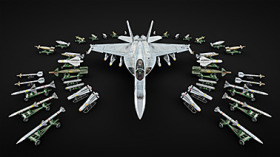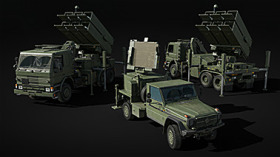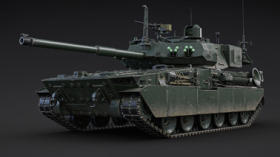
- PC
- MAC
- Linux
- Sistema Operativo: Windows 10 (64 bit)
- Processador: Dual-Core 2.2 GHz
- Memória: 4GB
- Placa Gráfica: Placa com DirectX 11: AMD Radeon 77XX / NVIDIA GeForce GTX 660. Resolução mínima suportada: 720p
- Network: Internet de banda larga.
- Disco: 17 GB
- Sistema Operativo: Windows 10/11 (64 bit)
- Processador: Intel Core i5, Ryzen 5 3600 ou superior
- Memória: 16 GB ou mais
- Placa Gráfica: Placa com DirectX 11 ou superior; Nvidia GeForce 1060 ou superior, Radeon RX 570 ou superior
- Network: Internet de banda larga.
- Disco: 60,2 GB
- Sistema Operativo: Mac OS Big Sur 11.0 ou versão mais recente
- Processador: Core i5 2.2GHz mínimo (Intel Xeon não suportado)
- Memória: 6 GB
- Placa Gráfica: Intel Iris Pro 5200 (Mac), equivalentes AMD/Nvidia para Mac. Resolução mínima suportada: 720p com suporte Metal.
- Network: Internet de banda larga.
- Disco: 21,5 GB
- Sistema Operativo: Mac OS Big Sur 11.0 ou versão mais recente
- Processador: Core i7 (Intel Xeon não suportado)
- Memória: 8 GB
- Placa Gráfica: Radeon Vega II ou superior com suporte Metal.
- Network: Internet de banda larga.
- Disco: 60,2 GB
- Sistema Operativo: Distribuições mais modernas do Linux de 64bit
- Processador: Dual-Core 2.4 GHz
- Memória: 4 GB
- Placa Gráfica: NVIDIA 660 com os drivers mais recentes (não mais de 6 meses) / equivalentes AMD com os drivers mais recentes com suporte Vulkan (não mais de 6 meses); Resolução mínima suportada: 720p.
- Network: Internet de banda larga.
- Disco: 21,5 GB
- Sistema Operativo: Ubuntu 20.04 64bit
- Processador: Intel Core i7
- Memória: 16 GB
- Placa Gráfica: NVIDIA 1060 com os drivers mais recentes (não mais de 6 meses) / equivalentes AMD (Radeon RX 570) com os drivers mais recentes (não mais de 6 meses) com suporte Vulkan.
- Network: Internet de banda larga.
- Disco: 60,2 GB
Hoje anunciamos o Panzerhaubitze 2000, um dos obuses mais modernos do mundo que vai ser adicionado em duas nações.
PzH 2000: Caça-tanques, Alemanha, Nível V
PzH 2000HU: Caça-tanques, Alemanha, Nível V, Premium via pacote com o lançamento da atualização
Características:
- Poderosa arma de 155 mm L52!
- Boa mobilidade.
- Depressão pobre.
- Pouca blindagem.
O Panzerhaubitze 2000 remonta ao programa SP70 do começo dos anos 70 aquando da colaboração entre a Alemanha, a Grã-Bretanha e a Itália. Este programa tinha como objetivo substituir os morteiros M109 em serviço por um veículo mais moderno com um morteiro mais poderoso e longo de 155 mm. No entanto, o projeto foi cancelado em 1986 devido a problemas no desenho e as empresas seguiram caminhos separados. A Grã-Bretanha seguiu com o desenho e produção do AS-90, enquanto a Alemanha seguiu com o Panzerhaubitze 2000. Em 1987 começaram os trabalhos no desenho do Panzerhaubitze 2000 pela Rheinmetall e pela Krauss-Maffei Wegmann, e só foi concluído em 1995, entrando em serviço no exército alemão em 1998.
A Húngria fez uma encomenda de 24 Panzerhaubitze 2000 em 2018 e recebeu os primeiros dois em Agosto de 2022. No verão de 2024 já tinham sido entregues 23. Estes veículos substituíram os antigos D-20 soviéticos de 152 mm que estavam em serviço nas forças armadas húngaras.
Introduzindo o Panzerhaubitze 2000!
Na atualização Storm Warning o Panzerhaubitze 2000 vai juntar-se à árvore da Alemanha, enquanto a Itália vai receber uma variante premium húngara com uma rede de camuflagem única. As munições HE desde poderoso obus é a única coisa que precisa para obliterar qualquer inimigo! Vamos aos detalhes.
Panzerhaubitze 2000 significa obus blindado 2000!
O Panzerhaubitze 2000 pode ser considerado um dos, se não o melhor obus autopropulsado do mundo, e também a peça de artilharia mais cara. Isto deve-se ao seu devastador obus de 155 mm L52 com aproximadamente 8 metros de comprimento. O ponto forte desta arma é as suas balísticas - pode disparar munições HE com uma velocidade bastante alta e são capazes de atingir o inimigo a distâncias impressionantes. Para longas distância, o telémetro pode ser usado em conjunto com a arma principal dada a exatidão da arma. Assegurem apenas que as munições atingem as áreas fracas do inimigo, as munições HE fazem o resto do trabalho.
Em 2019 a arma de 155 mm L52 do Panzerhaubitze 2000 bateu o recorde de alcance de tiro de 67 km!
Com aproximadamente 58 toneladas, o Panzerhaubitze 2000 consegue chegar a uns impressionantes 60 km/h em estrada graças ao motor de 1000 cavalos. Com esta velocidade vão poder chegar a pontos importantes no começo da batalha, ou fazer manobras rápidas de curto alcance.
No entanto, tamanha arma e mobilidade acarreta um problema, a armadura. O Panzerhaubitze 2000 tem placas de aço e alguma armadura adicional no teto, conhecida como armadura de ouriço, o que é suficiente para aguentar apenas tiros de metralhadora, mais do que isso penetra com toda a facilidade. A tripulação é composta por cinco homens: o comandante, o atirador, o motorista e dois municiadores. Mantenham em mente que o que as munições e os tripulantes estão perigosamente compactados no compartimento de combate!
É tudo por hoje! O Panzerhaubitze 2000 vai dar à Alemanha e à Itália um novo patamar de poder de fogo com a atualização Storm Warning. Não se esqueçam que a variante húngara da Itália vem com uma bela rede de camuflagem. Continuem de olho nas notícias para mais devblogs!
Por favor notem que as características do veículo em causa podem ser alteradas antes da sua introdução no jogo.
Excelente para acelerar a pesquisa do PzH 2000:

- Turm III (Nível VI, Alemanha)
- Conta premium para 15 dias
- 2000 Golden Eagles
Excelente para acelerar a pesquisa do PzH 2000:

- Leopard A1A1 L/44 (Nível VI, Alemanha)
- Conta premium para 15 dias
- 2000 Golden Eagles








